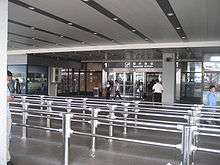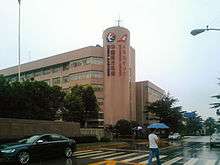Shanghai Hongqiao International Airport
| Shanghai Hongqiao International Airport 上海虹桥国际机场 Shànghǎi Hóngqiáo Guójì Jīchǎng | |||||||||||||||
|---|---|---|---|---|---|---|---|---|---|---|---|---|---|---|---|
 Logo of Shanghai Airport Authority | |||||||||||||||
|
| |||||||||||||||
| IATA: SHA – ICAO: ZSSS | |||||||||||||||
| Summary | |||||||||||||||
| Airport type | Public | ||||||||||||||
| Operator | Shanghai Airport Authority | ||||||||||||||
| Serves | Shanghai | ||||||||||||||
| Location | Changning-Minhang, Shanghai | ||||||||||||||
| Hub for | |||||||||||||||
| Elevation AMSL | 3 m / 10 ft | ||||||||||||||
| Coordinates | 31°11′53″N 121°20′11″E / 31.19806°N 121.33639°ECoordinates: 31°11′53″N 121°20′11″E / 31.19806°N 121.33639°E | ||||||||||||||
| Website | Hongqiao Airport | ||||||||||||||
| Map | |||||||||||||||
 SHA Location of airport in Shanghai | |||||||||||||||
| Runways | |||||||||||||||
| |||||||||||||||
| Statistics (2014) | |||||||||||||||
| |||||||||||||||
|
Source: [1] | |||||||||||||||
| Shanghai Hongqiao International Airport | |||||||||||
| Traditional Chinese | 上海虹橋國際機場 | ||||||||||
|---|---|---|---|---|---|---|---|---|---|---|---|
| Simplified Chinese | 上海虹桥国际机场 | ||||||||||
| |||||||||||
Shanghai Hongqiao International Airport (IATA: SHA, ICAO: ZSSS) is the main domestic airport serving Shanghai, with limited international flights. It is located near the town of Hongqiao in Changning District, 13 kilometres (8.1 mi) west of downtown, and is closer to the city center than Pudong Airport, Shanghai's main international airport.
Hongqiao Airport is a hub for China Eastern Airlines, Shanghai Airlines, Juneyao Airlines and Spring Airlines. In 2014, Hongqiao Airport handled 37,960,200 passengers, a growth of 21.3% over 2010, making it the 4th busiest airport in mainland China and the 21st busiest in the world.[2] The airport was also mainland China's 5th busiest airport in terms of cargo traffic and the 7th busiest by traffic movements. By the end of 2011 Hongqiao Airport hosted 22 airlines serving 82 scheduled passenger destinations.[3]
History
An airport was first built in the town of Hongqiao in the west of Shanghai in 1907, initially as a small military airfield. In March 1923, it was upgraded into the Hongqiao Airport for mixed civilian use. In 1937, Hongqiao was the site of the so-called 'Oyama Incident' in which a Japanese lieutenant was shot dead by Chinese Peace Preservation Corps soldiers in the lead-up to the Battle of Shanghai. During the Second Sino-Japanese War, the airport was occupied by the Japanese and used as an air force base. Its military use continued after being handed over to the Republic of China government and, later, the People's Republic of China government. From late 1963, it was rebuilt for civilian use, and was re-opened in April 1964. A major expansion took place from March to September 1984, and another from December 1988 to December 1991.
Hongqiao Airport served as Shanghai's primary airport until the completion of Pudong International Airport in 1999, when almost all international flights were moved to Pudong. The airport presently offers mainly domestic flights, as well as five international or cross-border routes with "city-to-city" service to central Tokyo's Haneda Airport, central Seoul's Gimpo Airport, central Taipei's Songshan Airport, Hong Kong's Chek Lap Kok Airport, and Macau's Macau International Airport.
On 1 January 2013, holders of passports issued by 45 countries do not need a visa if transiting through Hongqiao Airport provided they hold valid passports.
Terminal 2 and second runway


In preparation for the Shanghai Expo, on 16 March 2010 Hongqiao Airport completed a five-year 15.3-billion-yuan expansion project, which included a 3,300-meter second runway and the new Terminal 2, boosting Hongqiao's capacity to 40 million passengers a year.[4] Terminal 2 is four times the size of Terminal 1 and houses 90 percent of all airlines at the airport (Terminal 1 is now used only for international flights and Spring Airlines). With the new runway, Shanghai became the first city in China to have five runways for civilian use (Pudong and Hongqiao combined).
Ground transportation
Terminal 2 of the Hongqiao Airport (31°11′46″N 121°19′18″E / 31.19611°N 121.32167°E) is immediately adjacent to Shanghai Hongqiao Railway Station (31°11′46″N 121°18′58″E / 31.19611°N 121.31611°E), a major train hub served by the Beijing–Shanghai High-Speed Railway, the Shanghai–Hangzhou High-Speed Railway and the Shanghai–Nanjing Intercity High-Speed Railway. The airport's other terminal, Terminal 1 (31°11′50″N 121°20′32″E / 31.19722°N 121.34222°E), is across the airfield from Terminal 2.
The airport and the railway station are served by three stations of the metro network:[5]
- Hongqiao Railway Station: Line 2, Line 10
- Hongqiao Airport Terminal 2 Station: Line 2, Line 10
- Hongqiao Airport Terminal 1 Station: Line 10
The proposed extension of the Shanghai Maglev Train from Longyang Road through Shanghai South Railway Station to Hongqiao would connect the two airports. At top speed, the maglev would take only 15 minutes to travel the 55 km route. Original plans called for completing the extension by 2010, in time for the 2010 Shanghai World Expo; however, the Hongqiao extension has been indefinitely postponed due to protests.
Airlines and destinations
Other facilities

The airport has the head office of China Eastern Airlines, which is housed in the China Eastern Airlines Building,[8][9] and the head office of China Cargo Airlines.[10]
Incidents and accidents
- On 15 April 1999, Korean Air Lines Flight 6316, an MD-11F bearing registration HL7373, crashed shortly after takeoff from Hongqiao Airport to Seoul. After takeoff, the first officer contacted Shanghai Departure, which cleared the flight to climb to 1,500 metres (4,900 ft). When the aircraft climbed to 4,500 feet (1,400 m) in the corridor, the captain, after receiving two wrong affirmative answers from the first officer that the required altitude should be 1,500 ft (460 m), thought that the aircraft was 3,000 ft (910 m) too high. The captain then pushed the control column abruptly and roughly forward causing the plane to enter a rapid descent. Both crew members tried to recover from the dive, but were unable. All three occupants on board and five people on the ground were killed.[11]
- On 13 August 2011, Qatar Airways Flight 888, a Boeing 777-300ER en route from Doha International Airport to Shanghai's other international airport, Shanghai Pudong International Airport declared a low-fuel emergency and elected to divert to Shanghai Hongqiao International Airport. Air traffic control at Hongqiao ordered Juneyao Airlines Flight 1112, en route from Shenzhen Bao'an International Airport to Hongqiao, to terminate its approach and allow the Qatar Airways Boeing 777-300ER to land. The pilot of Juneyao Airlines Flight 1112 ignored repeated orders to abort their landing and give Flight 888 priority, ultimately forcing the Qatar Airways flight to go-around. Both aircraft landed safely without injury or damage to the aircraft. The incident led to penalties to Juneyao Airlines and the crew of the Juneyao plane by the Civil Aviation Administration of China, including the permanent revocation of the pilot's license in China.[12]
- On 7 June 2013, China Eastern Airlines Flight 2947, an Embraer EMB-145LI flying from Huai'an Lianshui Airport to Shanghai Hongqiao International Airport veered off of runway 18L at Hongqiao during landing. The plane came to a stop on an adjacent taxiway with its nose gear collapsed. No passengers or crew suffered any injuries, however the plane received substantial damage.[13]
See also
References
- ↑ 上海机场2014年完成旅客吞吐量近9000万人次. Carnoc. 1 January 2015.
- ↑ ACI releases World Airport Traffic Report 2010
- ↑ 民航局与上海市人民政府在沪签战略合作协议 (in Chinese). Carnoc. 6 April 2012.
- ↑ "Runway at Hongqiao ready for flight test". 10 January 2010.
- ↑ "Shanghai metro reaches Hongqiao Airport". Railway Gazette International. 16 March 2010.
- ↑ http://news.carnoc.com/list/319/319082.html
- ↑ China Eastern Airlines begin service to Macau from September
- ↑ "Exhibit B." p. 2. "2550 Hongqiao Road Hongqiao International Airport China Eastern Airlines Building" (Archive)
- ↑ "China Eastern Airlines Corp. Ltd. (CEA)." Yahoo! Finance. Retrieved on 3 October 2009. "China Eastern Airlines Corp. Ltd. 2550 Hong Qiao Road Shanghai, 200335 China – Map"
- ↑ "Directory:World airlines." Flight International. 25–31 March 2003. 45. "Hongqiao International Airport, Shanghai, 200335, China"
- ↑ Accident summary, Korean Air HL7373. aviation-safety.net
- ↑ Incident: Incident: Qatar B773 and Juneyao A320 near Shanghai on Aug 13th 2011, fuel emergency or not. The Aviation Herald. 24 August 2011.
- ↑ Accident: China Eastern E145 at Shanghai on Jun 7th 2013, runway excursion, nose gear collapse. The Aviation Herald. 7 June 2013.
External links
| Wikimedia Commons has media related to Shanghai Hongqiao International Airport. |
| ||||||||||||||||||||||||||||||||||||||||||||||||||||||||||||||||||||||||||||||||||||||
| ||||||||||||||||||||||||||||||||||||||||||||||||||||||
